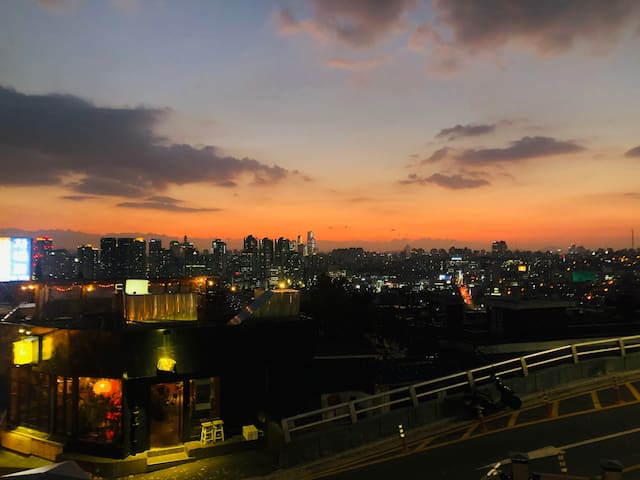관광
Seoul has a number of viewing platforms where visitors can enjoy the nighttime cityscape or gaze out onto the Hangang (River) but the tower's Digital Observatory is unique, offering an astonishing 360 degree panorama over the city, and 32 LCD screens recounting the 600-year history of Seoul. That is why the observatory is so popular and such a source of pride.
Situated on top of the N Plaza, the Roof Terrace is a spacious wooden viewing deck whose exotic atmosphere makes it very popular with lovers. A recent attraction for courting couples is "Locks of Love," thousands of padlocks attached to the fence by romantic Seoulites symbolizing their undying affection.
686 lokal ang nagrerekomenda
N Seoul Tower
Seoul has a number of viewing platforms where visitors can enjoy the nighttime cityscape or gaze out onto the Hangang (River) but the tower's Digital Observatory is unique, offering an astonishing 360 degree panorama over the city, and 32 LCD screens recounting the 600-year history of Seoul. That is why the observatory is so popular and such a source of pride.
Situated on top of the N Plaza, the Roof Terrace is a spacious wooden viewing deck whose exotic atmosphere makes it very popular with lovers. A recent attraction for courting couples is "Locks of Love," thousands of padlocks attached to the fence by romantic Seoulites symbolizing their undying affection.
Namsan Park is the largest park in Seoul and is home to many species of trees, plants, and animals. The park is well-known for its beautiful walking trails which allow visitors to see the local wildlife, such as its squirrels. The park covers a large area and features a number of tourist attractions including Baekbeom Square, the Namsan Cable Car and Namsan Seoul Tower, and statues of famous figures in Korean history. A number of events take place at the park and one of the biggest is the annual cherry blossom festival in April. The Cherry Blossom Path in Namsan Park is the longest trail of cherry trees anywhere in the city and is spectacular in full bloom.
65 lokal ang nagrerekomenda
Namsan
Namsan Park is the largest park in Seoul and is home to many species of trees, plants, and animals. The park is well-known for its beautiful walking trails which allow visitors to see the local wildlife, such as its squirrels. The park covers a large area and features a number of tourist attractions including Baekbeom Square, the Namsan Cable Car and Namsan Seoul Tower, and statues of famous figures in Korean history. A number of events take place at the park and one of the biggest is the annual cherry blossom festival in April. The Cherry Blossom Path in Namsan Park is the longest trail of cherry trees anywhere in the city and is spectacular in full bloom.
During Japanese colonial rule, the area had a military shooting range. After Korea gained independence, the American military government controlled the area but did not exercise that control thoroughly and Koreans displaced by the war were able to settle in Haebangchon. In the post-colonial years, foreigners, North Koreans who had fled south, and refugees fleeing the war settled Haebangchon. The displaced people occupied the old Japanese military buildings at first, but following an eviction by the American military, they settled in huts built at the old shooting range. The novel "Obaltan" ("The Aimless Bullet") describes the poverty and hardscrabble existence of the residents of Haebangchon.
However, since 2010 there has been a gradual transformation. For a long time, Haebangchon was one of Seoul's most deprived places. This is no longer the case. Young people find Haebangchon to have an uncanny charm with a unique atmosphere. Not only is there a plethora of good restaurants and cafes, it is also very close to another popular spot, Gyeongnidan Road. Because of the two areas' proximity, there is an exciting synergy of their energies. Whether it's the weekend or a weekday, Haebangchon is always packed.
Haebangchon
16 Sinheung-ro 3ga-gilDuring Japanese colonial rule, the area had a military shooting range. After Korea gained independence, the American military government controlled the area but did not exercise that control thoroughly and Koreans displaced by the war were able to settle in Haebangchon. In the post-colonial years, foreigners, North Koreans who had fled south, and refugees fleeing the war settled Haebangchon. The displaced people occupied the old Japanese military buildings at first, but following an eviction by the American military, they settled in huts built at the old shooting range. The novel "Obaltan" ("The Aimless Bullet") describes the poverty and hardscrabble existence of the residents of Haebangchon.
However, since 2010 there has been a gradual transformation. For a long time, Haebangchon was one of Seoul's most deprived places. This is no longer the case. Young people find Haebangchon to have an uncanny charm with a unique atmosphere. Not only is there a plethora of good restaurants and cafes, it is also very close to another popular spot, Gyeongnidan Road. Because of the two areas' proximity, there is an exciting synergy of their energies. Whether it's the weekend or a weekday, Haebangchon is always packed.

